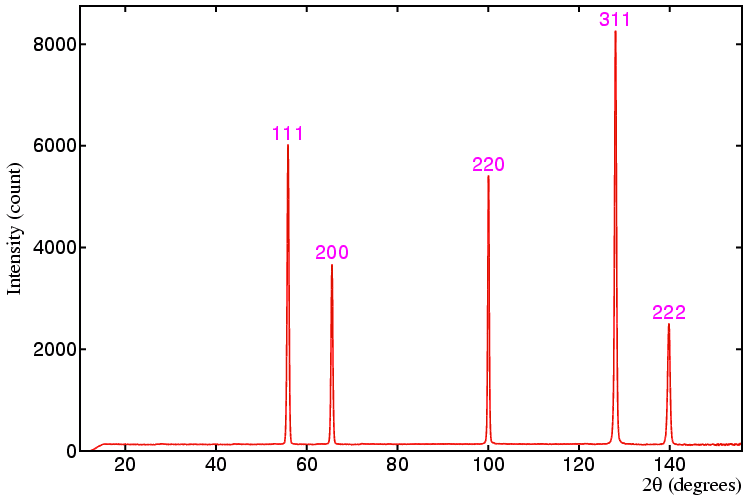 |
Wavelength Refinement |
 Course Material Index
Course Material Index
 Section Index
Section Index
 Previous Page
Previous Page
 Next Page
Next Page
Wavelength Refinement
For angle-dispersive powder diffraction using non-laboratory radiation sources,
it is often the wavelength of the incident radiation that requires calibration.
This can be readily achieved by using the standard samples described
previously. Instead of refining the lattice parameters, these are left
fixed at the known pre-calibrated values and the wavelength itself
is refined. Note that it is not possible to refine the wavelength and
the unit-cell parameters simultaneously; it is a chicken and egg situation
where one variable can be refined from knowing the other and vice versa.
The data below shows a neutron diffraction pattern of nickel powder
(a = 3.5238 Å) collected with
λ ≈ 1.9 Å (on the instrument
D1A at the ILL, Grenoble). Nickel has a face-centred cubic structure
and 5 Bragg peaks were measurable at this wavelength as shown in the figure
below:

 You can click on the icon to get a list of reflections for nickel powder.
It is a relatively simple procedure to match them to the peaks as
shown in the figure above.
You can click on the icon to get a list of reflections for nickel powder.
It is a relatively simple procedure to match them to the peaks as
shown in the figure above.
From the 2θ positions of the five reflections
the incident neutron wavelength can be refined.
 Click on the icon and submit the pre-completed form without editing
any of the values in order to see the output from the refinement program.
In the output you should see the refined values for both the wavelength and the
2θzero error.
You should note that this instrument was run with
a much larger 2θzero error than that
normally tolerated for a laboratory X-ray diffractometer!
As with a unit-cell refinement using data collected to high
scattering angle, the precision of the wavelength is relatively high.
If only low-angle data had been used, the precision would have been much worse.
Click on the icon and submit the pre-completed form without editing
any of the values in order to see the output from the refinement program.
In the output you should see the refined values for both the wavelength and the
2θzero error.
You should note that this instrument was run with
a much larger 2θzero error than that
normally tolerated for a laboratory X-ray diffractometer!
As with a unit-cell refinement using data collected to high
scattering angle, the precision of the wavelength is relatively high.
If only low-angle data had been used, the precision would have been much worse.
 Course Material Index
Course Material Index
 Section Index
Section Index
 Previous Page
Previous Page
 Next Page
Next Page


